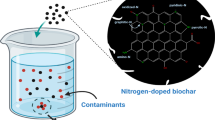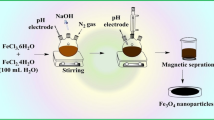Abstract
A column sorbent for arsenic was obtained through immobilization of highly branched polyethylenimine (PEI) on graphene oxide (GO). The composite material enables speciation of arsenic by tuning the pH of the sample solution which governs the surface charge of the sorbent, depending on whether amino groups (-NH2) are present (at high pH) or ammonium groups (-NH3+; at low pH). The composite can be applied to improved speciation of arsenic (compared to unmodified GO). There is no need for oxidation or reduction of arsenic. A column procedure was applied for the sequestered extraction and speciation of As(III) and As(V) from environmental water samples before their determination by hydride generation-microwave induced plasma-atomic emission spectrometry. The method has a preconcentration factor of 440 for As(III) and of 400 for As(V). The limits of detection (at 3 S/N) are extremely low, being 1.8 ± 0.2 ngL−1 for As(III) and 1.3 ± 0.08 ngL−1 for As(V). This is much lower than the arsenic guideline value of 10 μgL−1 as given by the WHO.

Graphene oxide interconnected with polyethyleneimine has been employed for the speciation and determination of arsenic. Quantitation by atomic emission spectroscopy reveals a high preconcentration factor (440 and 400) and low LODs of 1.8 ± 0.2 and 1.3 ± 0.08 ngL−1for As(III) and As(V), respectively.




Similar content being viewed by others
References
Nordstrom DK (2002) Worldwide occurrences of arsenic in ground water. Science 296:2143–2146
Rodriguez-Lado L, Sun G, Berg M, Zhang Q, Xue H, Zheng Q, Johnson CA (2013) Groundwater arsenic contamination throughout China. Science 341:866–868
Vermeulen M, Nuyts G, Sanyova J, Vila A, Buti D, Suuronen J, Janssens K (2016) Visualization of As(III) and As(V) distributions in degraded paint micro-samples from Baroque- and Rococo-era paintings. J Anal At Spectrom 31:1913–1921
Ahmad H, Ahmad A, Islam SS (2017) Magnetic Fe3O4@poly(methacrylic acid) particles for selective preconcentration of trace arsenic species. Microchim Acta 184(7):2007–2014
Dey B, Saha R, Mukherjee P (2013) A luminescent-water soluble inorganic co-crystal for a selective pico-molar range arsenic(III) sensor in water medium. Chem Commun 49:7064–7066
Tanabe CK, Hopfer H, Gilleland G, Liba A, Ebelerab SE, Nelson J (2016) Total arsenic analysis in Californian wines with hydride generation–microwave plasma–atomic emission spectroscopy (HG-MP-AES). J Anal At Spectrom 31:1223–1227
Gong X, Liu G, Li Y, Denis YWY, Teoh WY (2016) Functionalized-graphene composites: fabrication and applications in sustainable energy and environment. Chem Mater 28:8082−8118
Perreault F, Fonseca de Faria A, Elimelech M (2015) Environmental applications of graphene-based nanomaterials. Chem Soc Rev 44:5861−5896
Hummers WS, Offeman RE (1958) Preparation of graphitic oxide. J Am Chem Soc 80:1339–1339
Klimova K, Pumera M, Luxa J, Jankovsky O, Sedmidubsky D, Matejkova S, Sofer Z (2016) Graphene oxide sorption capacity toward elements over the whole periodic table: a comparative study. J Phys Chem C 120(120):24203–24212
Xiong Y, Cui X, Zhang P, Wang Y, Lou Z, Shan W (2017) Improving Re(VII) adsorption on diisobutylamine-functionalized graphene oxide. ACS Sustain Chem Eng 5:1010−1018
Tang S, Zhang H, Lee HK (2016) Advances in sample extraction. Anal Chem 88:228–224
Sitko R, Zawisza B, Talik E, Janik P, Osoba G, Feist B, Malicka E (2014) Spherical silica particles decorated with graphene oxide nanosheets as a new sorbent in inorganic trace analysis. Anal Chim Acta 834:22−29
Islam A, Ahmad H, Noushi Z, Kumar S (2014) Graphene oxide sheets immobilized polystyrene for column preconcentration and sensitive determination of lead by flame atomic absorption spectrometry. ACS Appl Mater Interfaces 6:13257–13265
Wen T, Wu X, Tan X, Wang X, Xu A (2013) One-pot synthesis of water-swellable Mg−Al layered double hydroxides and graphene oxide nanocomposites for efficient removal of As(v) from aqueous solutions. ACS Appl Mater Interfaces 5:3304−3311
Gong L, Du B, Pan L, Liu Q, Yang K, Wang W, Zhao H, Wu L, He Y (2017) Colorimetric aggregation assay for arsenic(III) using gold nanoparticles. Microchim Acta 184(4):1185–1190
Sanghavi BJ, Gadhari NS, Kalambate PK, Karna SP, Srivastava AK (2015) Potentiometric stripping analysis of arsenic using a graphene paste electrode modified with a thiacrown ether and gold nanoparticles. Microchim Acta 182(7–8):1473–1481
Jiang TJ, Guo Z, Liu JH, Huang XJ (2015) Electroadsorption-assisted direct determination of trace arsenic without interference using transmission x-ray fluorescence spectroscopy. Anal Chem 87:8503–8509
Deng F, Dong R, Yu K, Luo X, Tu X, Luo S, Yang L (2013) Determination of trace total inorganic arsenic by hydride generation atomic fluorescence spectrometry after solid phase extraction-preconcentration on aluminium hydroxide gel. Microchim Acta 180:509–515
Hassanpoor S, Khayatian G (2015) Azar ARJ (2015) ultra-trace determination of arsenic species in environmental waters, food and biological samples using a modified aluminium oxide nanoparticle sorbent and AAS detection after multivariate optimization. Microchim Acta 182:1957–1965
Thomsen V, Schatzlein D, Mercuro D (2003) Limits of detection in spectroscopy. Spectroscopy 18:112–114
Acknowledgments
The author (Dr. Hilal Ahmad) is grateful to Science and Engineering Research Board (SERB) to provide fund under “National Postdoctoral Fellowship” program for the year 2017-2018, project No. NPDF-000995.
Author information
Authors and Affiliations
Corresponding author
Ethics declarations
The authors declare no conflicts of interest.
Electronic supplementary material
ESM 1
(DOCX 107 kb)
Rights and permissions
About this article
Cite this article
Ahmad, H., Umar, K., Ali, S.G. et al. Preconcentration and speciation of arsenic by using a graphene oxide nanoconstruct functionalized with a hyperbranched polyethyleneimine. Microchim Acta 185, 290 (2018). https://doi.org/10.1007/s00604-018-2829-z
Received:
Accepted:
Published:
DOI: https://doi.org/10.1007/s00604-018-2829-z




